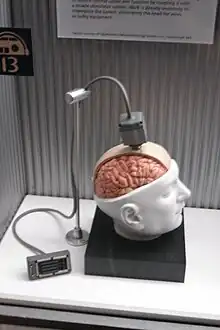Cyberkinetics

Cyberkinetics is an American company with roots tied to the University of Utah. It was co-founded by John Donoghue, Mijail Serruya, Gerhard Friehs of Brown University, and Nicho Hatsopoulos of the University of Chicago. The Braingate technology and related Cyberkinetic’s assets were acquired by BrainGate in 2008. BrainGate, Inc.[1] is a privately held company that holds technology that can help transform thoughts into action.[2]
Funding
Scientists behind the project used $9.3 million in first round funding led by Oxford Bioscience Partners. A 2002 merger with Bionic Technologies, co-founded by Brian Hatt and Richard A. Normann (the inventor of the Utah array) added to a tech team armed with intellectual property rights gained from Brown, MIT, and others. They say they're three to five years away from putting a product on the market.
According to their latest SEC filing, the Founders of the company resigned from the Board of Directors at the end of October, 2008.
Merger and renaming
In late 2004, Cyberkinetics initiated a reverse merger with a Texas company in order to gain access to the public market. The resulting company was renamed Cyberkinetics Neurotechnology Systems, Inc. and its shares are listed under the symbol CYKN.OB. In 2009, the BrainGate business and related Cyberkinetic’s assets were sold to privately held Braingate, Inc.[2]
In early 2009, Cyberkinetics was acquired by Blackrock Microsystems, LLC.[3]
Clinical trials
Since July 8, 2009 clinical trials are being conducted for the Brain Gate 2 Neural Interface System.[4]
Since July 16, 2009 the pilot clinical trial of the BrainGate2 Neural Interface System is registered at ClinicalTrials.gov.[4][5]
See also
References
- ↑ "Braingate".
- 1 2 Braingate gets a new lease on life, The Boston Globe, August, 2009
- ↑ "Blackrock Microsystems Obtains Expanded 510(k) to Market NeuroPort System". PRWeb. 15 July 2009.
- 1 2 "BrainGate - Home". Braingate2.org.
- ↑ "BrainGate2: Feasibility Study of an Intracortical Neural Interface System for Persons With Tetraplegia - Full Text View". ClinicalTrials.gov.